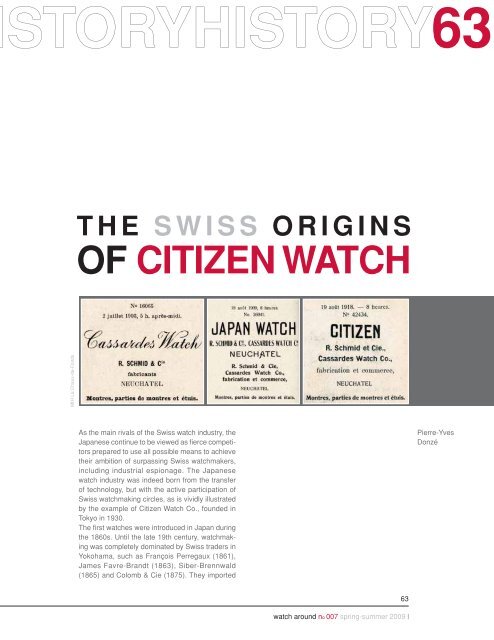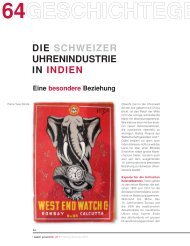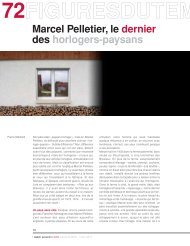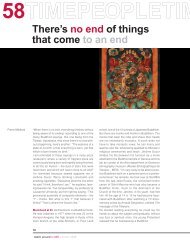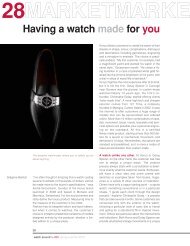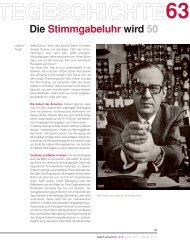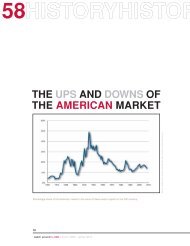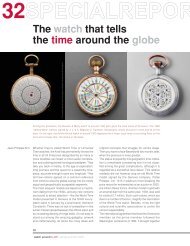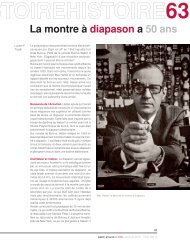OF CITIZEN WATCH - Watch Around
OF CITIZEN WATCH - Watch Around
OF CITIZEN WATCH - Watch Around
Create successful ePaper yourself
Turn your PDF publications into a flip-book with our unique Google optimized e-Paper software.
STORYHISTORYHIS 63<br />
THE SWISS ORIGINS<br />
<strong>OF</strong> <strong>CITIZEN</strong> <strong>WATCH</strong><br />
MIH La Chaux-de-Fonds<br />
As the main rivals of the Swiss watch industry, the<br />
Japanese continue to be viewed as fierce competitors<br />
prepared to use all possible means to achieve<br />
their ambition of surpassing Swiss watchmakers,<br />
including industrial espionage. The Japanese<br />
watch industry was indeed born from the transfer<br />
of technology, but with the active participation of<br />
Swiss watchmaking circles, as is vividly illustrated<br />
by the example of Citizen <strong>Watch</strong> Co., founded in<br />
Tokyo in 1930.<br />
The first watches were introduced in Japan during<br />
the 1860s. Until the late 19th century, watchmaking<br />
was completely dominated by Swiss traders in<br />
Yokohama, such as François Perregaux (1861),<br />
James Favre-Brandt (1863), Siber-Brennwald<br />
(1865) and Colomb & Cie (1875). They imported<br />
Pierre-Yves<br />
Donzé<br />
63<br />
watch around no 007 spring-summer 2009 |
HISTORYHISTORYH<br />
Photos Citizen<br />
The Citizen brand launched in 1918 by Rodolphe Schmid, who employed 200 people in his Tokyo factory by the late<br />
1920s, gave rise to the Citizen <strong>Watch</strong> Co. in 1930.<br />
Swiss watches and sold them to Japanese businessmen<br />
who handled their distribution throughout<br />
the country.<br />
Protectionism encourages chablonnage. <strong>Watch</strong><br />
sales grew significantly with industrialisation and the<br />
development of railways : the number of units<br />
imported rose from 47,000 in 1880 to 145,000 in<br />
1900. This boom encouraged several Swiss watch<br />
merchants to seek independence from Swiss<br />
importers by producing watches themselves. It was<br />
in this context that the Seiko watch factory was set<br />
up in 1892. Its founder was a watch merchant<br />
named Kintaro Hattori, who worked with the Swiss<br />
importers in Yokohama. He succeeded in producing<br />
his own pocket-watches during the 1890s with the<br />
help of engineers trained at the watchmaking school<br />
in Le Locle and using machine tools imported from<br />
Switzerland and the United States. However, the<br />
watches made in Japan were much more expensive<br />
than their imported counterparts. To protect his own<br />
watches, Hattori, who had good political connections,<br />
instigated successive rises in Japanese customs<br />
duties. Import taxes on gold watches jumped<br />
from 5% prior to 1899 to 50% in 1906.<br />
The Swiss importers of Yokohama reacted to these<br />
protectionist policies by turning to chablonnage,<br />
which consisted of importing kits of unassembled<br />
parts that were less prohibitively taxed and then<br />
making up the watches in workshops on Japanese<br />
territory. Hattori also purchased some of these<br />
parts. Chablonnage gained considerable momentum<br />
between the two world wars. Movements<br />
accounted for 31% of the total volume of Swiss<br />
horological exports to Japan between 1900 and<br />
1915, rising to 42 % between 1915 and 1925<br />
and 81% from 1925 to 1940. This strategy was<br />
severely criticised in Switzerland because it transplanted<br />
the industry’s activities to other countries.<br />
It nevertheless remained the essential channel for<br />
the transfer of technology.<br />
Industrial transplantation causes alarm.<br />
Tavannes <strong>Watch</strong> was one of the key players in this<br />
development. Its watches were successively<br />
assembled and cased up by two small Japanese<br />
manufacturers. The first was the company founded<br />
in Tokyo in 1914 by Kono Shohei and headed by a<br />
former technical director of Hattori. It assembled<br />
Tavannes <strong>Watch</strong> kits, sold under the Pacific brand<br />
name. After this company was bought up by the<br />
Matsumura alarm clock company, the Tavannes<br />
<strong>Watch</strong> importer in Japan, Takara Trading, continued<br />
making watches from imported kits until its factory<br />
64<br />
| watch around no 007 spring-summer 2009
ISTORYHISTORYH<br />
was destroyed by fire in 1933. The activities of<br />
Tavannes <strong>Watch</strong> in Japan caused a great deal of<br />
alarm within the Swiss watch industry in the early<br />
1930s, since it seemed to have planned on setting<br />
up a movement factory there in 1932. Rolex wrote<br />
to the Federal Office for Industry, Crafts and Trades<br />
and Labour (<strong>OF</strong>IAMT), expressing strong opposition:<br />
“Once a movement factory is established in<br />
Japan by a Swiss company as large as the one in<br />
question, we can say goodbye forever to Swiss articles<br />
for the East and the Far East. After a few years<br />
these [Japanese-made] models will spread around<br />
the world.” While the statement was undoubtedly<br />
exaggerated, it certainly reflected the extreme concern<br />
aroused by industrial transplantation.<br />
Citizen’s Swiss foundations. Nonetheless, that is<br />
exactly what occurred with the development of the<br />
business of an important watch dealer who settled<br />
in Yokohama during the 1890s. Rodolphe Schmid<br />
was born in Neuchâtel in 1871, and in 1894 moved<br />
to Yokohama, where he soon asserted himself as<br />
one of the main watch merchants. By the following<br />
year, he was the city’s third largest watch importer,<br />
with more than 20,000 units. He also owned a factory<br />
in Neuchâtel, which was renamed Cassardes<br />
<strong>Watch</strong> in 1903.<br />
Directly affected by the protectionist customs<br />
duties, Schmid transferred part of his activities to<br />
Japan. He began importing kits of parts that he then<br />
had assembled in a small workshop he owned in<br />
Yokohama. In order to keep this trade supplied with<br />
components, his family created a watchcase factory,<br />
Jobin & Cie., in Neuchâtel in 1908. In 1913, a<br />
new step in the transfer process was taken with the<br />
production of cases in Japan. Schmid’s Japanese<br />
factory, which was relocated to Tokyo in 1912,<br />
enjoyed strong growth. He adopted new brand<br />
names for his watches, including Japan <strong>Watch</strong><br />
(1909) as well as Gunjin Tokei (1910), for a model<br />
intended for the army. Finally, in 1918, he opted for<br />
the Citizen brand name. His workforce grew from<br />
about 30 in 1913 to 110 in 1920, and to around 200<br />
by 1928. By then, his company was the country’s<br />
second largest watch manufacturer, behind Seiko.<br />
Schmid’s factory gave rise to the Citizen <strong>Watch</strong> Co.<br />
in 1930. This Japanese watch company was born<br />
from the merger between Schmid and the Shokosha<br />
workshop, which had been founded in Tokyo by a<br />
jeweller and aspiring watchmaker, Kamekichi<br />
Yamasaki. Financial troubles had however driven<br />
Yamasaki’s company to bankruptcy in the late<br />
1920s.<br />
Citizen <strong>Watch</strong> was founded with a share capital of<br />
200,000 yen divided into 20,000 shares. Schmid<br />
would have liked to acquire half the capital but was<br />
unable to – probably for political reasons, since foreign<br />
businessmen were encountering increasing<br />
hostility in Japan during the 1930s. Acquiring only<br />
a minor stake of 1.5%, Schmid nevertheless indirectly<br />
controlled the new company through the<br />
managers of his own factory.<br />
Principal shareholders of Citizen <strong>Watch</strong> Co., 1930<br />
Name Activity Shares (number) Shares (%)<br />
Shinji Nakajima Manager, R. Schmid & Co, Tokyo 2,449 12.2<br />
Kanamori Masutaro <strong>Watch</strong> wholesaler, Yokohama 2,200 11.0<br />
Kosaburo Nakajima – 2,125 10.6<br />
Osawa Co <strong>Watch</strong> trading company, Kyoto 1,854 9.3<br />
Kura Kawamura Employee of a watch wholesaler, Tokyo 1,045 5.2<br />
Kamekichi Yamasaki Founder of the Shokosha company, Tokyo 715 3.6<br />
Oscar Abegg Director, R. Schmid & Co, Tokyo 684 3.4<br />
Eimatsu Tsurumaki – 620 3.1<br />
Nakajima Co Trading company, Tokyo 543 2.7<br />
Kanamori Masusaburo – 543 2.7<br />
Small shareholders (100 individuals) 7222 36.2<br />
Total 20,000 100.0<br />
65<br />
watch around no 007 spring-summer 2009 |
HISTORYHISTORYH<br />
EX<br />
E<br />
Capital structure. Shareholders in Citizen <strong>Watch</strong><br />
came from two different milieus. First of all, there<br />
was a group of Schmid’s employees, headed by<br />
his marketing director, Shinji Nakajima. Born in<br />
1864, Nakajima had worked for several companies<br />
and travelled around the United States before joining<br />
Schmid in 1897. He was the first to take the<br />
reins of Citizen. Two other major shareholders,<br />
also called Nakajima and officially domiciled in<br />
Tokyo, were possibly relatives. There was also one<br />
Swiss among the shareholders, Oscar Abegg,<br />
director of the Tokyo factory and Schmid’s representative<br />
in Japan during his frequent absences<br />
from the country. The other main group of shareholders<br />
was composed of Japanese watch<br />
merchants, who invested in the company at<br />
Nakajima’s request. Osawa Co. acquired a fairly<br />
substantial stake, while four other trading companies<br />
also invested in the new firm : Nakajima,<br />
Furutani, Okasei and Izumiya Clock.<br />
Citizen <strong>Watch</strong> began operations in 1930. Initially,<br />
the Citizen workers merely assembled stocks of<br />
parts for Shokosha. But these proved hard to sell<br />
and the company ran into difficulties. Operating at<br />
a loss until 1933, it was kept alive by the Yasuda<br />
Bank. Citizen <strong>Watch</strong> also faced worker discontent,<br />
MPL<br />
A<br />
RY<br />
66<br />
| watch around no 007 spring-summer 2009
ISTORYHISTORYH<br />
The Citizen Group currently employs 18,000 people, mainly<br />
in watchmaking, electronics, machine-tools and jewellery.<br />
expressed by a strike in 1933. In the end, it was the<br />
development and marketing of wristwatches that<br />
enabled it to improve its situation, thanks to cooperation<br />
with Schmid.<br />
Technical assistance. Schmid’s involvement with<br />
Citizen was to prove essential in terms of technical<br />
assistance. He imported machine tools in 1933 and<br />
had an engineer in Geneva draw up plans for new calibres<br />
the following year. This partnership was reinforced<br />
by the Star Shokai company, which Citizen had<br />
acquired in 1932. This firm had been founded in 1926<br />
by Schmid, Nakajima and Suzuki to import Swiss<br />
Mido watches to Japan. The three wristwatches<br />
developed by Citizen up until the end of World War II<br />
(1931, 1935 and 1941) are in fact all copies of Mido<br />
products. The technical assistance provided by<br />
Schmid thus enabled Citizen to improve its position<br />
during the mid-1930s. It built a new factory in 1934<br />
and began exporting its products to China from 1936<br />
onwards. In 1939, Citizen produced almost 248,000<br />
watches, corresponding to 15% of national production.<br />
It was still far behind Hattori and its 1.3 million<br />
units, but well ahead of imported watches, which were<br />
down to fewer than 50,000 units since 1930.<br />
Rodolphe Schmid ceased his activities in Japan<br />
in the mid-1930s and returned to Switzerland,<br />
probably to Geneva, where his firm had been<br />
established as a marketing company since the<br />
1920s. He nonetheless remained firmly attached<br />
to Citizen, subscribing to the various share capital<br />
increases of the Japanese company during the<br />
war and still appearing on the 1948 list of shareholders.<br />
Technology transfer. The history of Citizen is a<br />
classic example of a watch industry born from a<br />
technology transfer process. After the war, it<br />
embarked on international expansion built on<br />
cooperation with foreign companies, including the<br />
American firm Bulova for the production of tuningfork<br />
watches (1960), the Swiss firm Méroz for<br />
watch jewels (1963), and the French firm Lip for<br />
electrical watches (1964). It also set up various<br />
production sites around the world (India, Mexico,<br />
South Korea, Hong Kong, Germany).<br />
Chablonnage not only promoted the emergence of<br />
watch companies in Japan, but also in the United<br />
States, Russia and Italy. It was an attempt to fight<br />
this new competition and to maintain production in<br />
Switzerland that led the Swiss watch industry to<br />
create a cartel in the 1930s, known as the “watchmaking<br />
statute” (statut horloger). And that will be<br />
the subject of an article in the next issue. •<br />
67<br />
watch around no 007 spring-summer 2009 |


